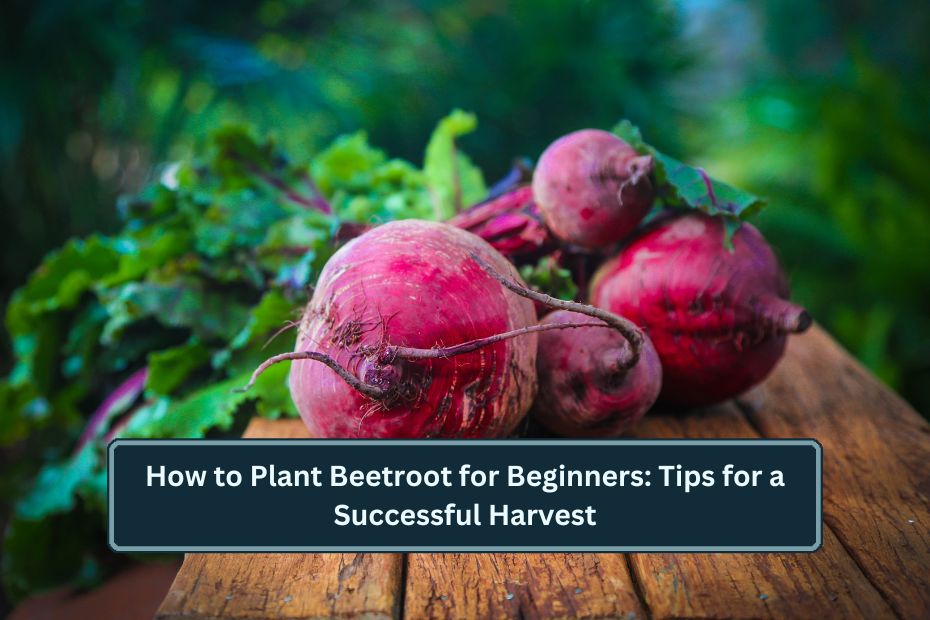Beetroot is a delicious and nutritious root vegetable that can be easily grown in your garden. Whether you want to add them to salads, soups, or juices, growing your own beets is a rewarding experience. In this article, we will guide you through the simple steps of planting beetroot, from preparing the soil to harvesting your crops. With a little care and attention, you’ll soon be enjoying fresh, homegrown beets!
1. Choose the Right Location for Planting
Beetroot thrives in full sunlight, so it’s important to choose a spot in your garden that gets at least 6 to 8 hours of direct sunlight each day. Beets prefer slightly sandy, well-draining soil with a pH between 6.0 and 7.0. Avoid areas with heavy clay soil, as this can cause the roots to become misshapen or struggle to grow.
Why It’s Important:
- Beets need plenty of sunlight to grow well.
- Well-draining soil prevents waterlogging and promotes healthy root development.
2. Prepare the Soil
Before planting, prepare the soil by loosening it to a depth of about 12 inches (30 cm). You can use a garden fork or tiller to break up any compacted soil. Add organic matter, such as compost or well-rotted manure, to improve soil fertility and drainage. Beets also prefer slightly acidic soil, so adding a little lime if your soil is too acidic can help.
Why It’s Important:
- Loose, nutrient-rich soil allows roots to grow freely and reach their full potential.
- Organic matter helps improve soil structure and adds nutrients.
3. Planting Beetroot Seeds
Beetroot is typically grown from seeds, and you can plant them directly into the ground. Space your beetroot seeds about 1 to 2 inches apart in rows, with each row spaced about 12 to 18 inches apart. Plant the seeds about 1 inch deep. If you’re planting in rows, make sure to thin the seedlings once they have sprouted to ensure they have enough space to grow properly.
Tips for Planting:
- Plant beetroot seeds in early spring or late summer, depending on your climate.
- In areas with a short growing season, start the seeds indoors and transplant them later.
- You can plant beets in containers if space is limited in your garden.
4. Watering and Caring for Beets
Beetroot requires regular watering, especially during dry spells. Aim to water deeply about once a week, ensuring the soil stays moist but not waterlogged. Be careful not to overwater, as this can cause the roots to rot. Mulching around the plants can help retain moisture and prevent weeds from competing for nutrients.
Why It’s Important:
- Consistent moisture helps beets grow evenly and prevents the roots from becoming tough.
- Mulching conserves water and keeps weeds under control.
5. Thin Out the Seedlings
Once your beetroot seeds have sprouted, you will need to thin the seedlings. Thin them to about 3 to 4 inches apart to give each beetroot enough space to grow large and healthy. You can eat the thinned seedlings as baby greens, which are full of flavor and nutrition!
Why It’s Important:
- Proper spacing allows each plant to grow strong, large roots.
- Thinning helps prevent overcrowding and competition for nutrients.
6. Fertilizing Beetroots
Beets benefit from regular feeding, especially during their early growth stages. Use a balanced fertilizer that is rich in potassium and phosphorus, which helps with root development. Avoid high-nitrogen fertilizers, as these can cause excessive leaf growth at the expense of the roots.
Why It’s Important:
- Fertilizing helps your beets grow healthy and productive.
- Potassium and phosphorus are key nutrients for healthy root development.
7. Harvesting Beets
Beets are typically ready to harvest in about 50 to 70 days, depending on the variety. You can begin harvesting when the roots reach about 1.5 to 2 inches in diameter. Gently pull the beets from the soil, or use a fork to lift them without damaging the roots. If you want larger beets, you can leave them in the ground a little longer, but be sure to harvest before the weather gets too hot.
Why It’s Important:
- Beets can be harvested at different sizes, depending on your preference.
- Harvesting at the right time ensures the roots are tender and flavorful.
8. Storing Your Harvest
After harvesting, trim off the beet greens, leaving about 1 inch of the stem to prevent them from drying out. Store the beets in a cool, dry place. Beets can be kept in the refrigerator for up to a few weeks or stored in a root cellar for longer-term storage.
Tips for Storing:
- Beet greens can be eaten as a tasty addition to salads or cooked dishes.
- Beets can also be pickled, roasted, or frozen for later use.
Planting beetroot is a simple and rewarding gardening activity that can yield delicious results. By choosing the right location, preparing the soil, and following a few basic care steps, you can grow your own beets at home. Beets are not only nutritious but also versatile in the kitchen, adding color and flavor to a wide variety of dishes. Whether you are a seasoned gardener or just starting out, beets are a great crop to include in your garden. Happy planting!
Visit Home

